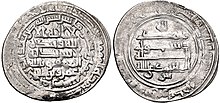
The Saffarid dynasty was a Persianate dynasty of eastern Iranian origin that ruled over parts of Persia, Greater Khorasan, and eastern Makran from 861 to 1003. One of the first indigenous Persian dynasties to emerge after the Islamic conquest, the Saffarid dynasty was part of the Iranian Intermezzo. The dynasty's founder was Ya'qub bin Laith as-Saffar, who was born in 840 in a small town called Karnin (Qarnin), which was located east of Zaranj and west of Bost, in what is now Afghanistan. A native of Sistan and a local ayyār, Ya'qub worked as a coppersmith (ṣaffār) before becoming a warlord. He seized control of the Sistan region and began conquering most of Iran and Afghanistan, as well as parts of Pakistan, Tajikistan and Uzbekistan.

Ya'qūb ibn al-Layth al-Saffār, was a coppersmith and the founder of the Saffarid dynasty of Sistan, with its capital at Zaranj. Under his military leadership, he conquered much of the eastern portions of Greater Iran consisting of modern-day Iran, Afghanistan, Turkmenistan, Uzbekistan, Tajikistan as well as portions of western Pakistan and a small part of Iraq. He was succeeded by his brother, Amr ibn al-Layth.

Ahmad ibn Ismail was amir of the Samanids (907–914). He was the son of Ismail Samani. He was known as the "Martyred Amir".

Amr ibn al-Layth or Amr-i Laith Saffari was the second ruler of the Saffarid dynasty of Iran from 879 to 901. He was the son of a whitesmith and the younger brother of the dynasty's founder, Ya'qub ibn al-Layth al-Saffar.

Abu'l-Hasan Tahir ibn Muhammad ibn Amr was amir of the Saffarid amirate from 901 until 909. He was the son of Muhammad ibn Amr.

Muhammad ibn 'Ali ibn al-Layth was amir of the Saffarid amirate from 910 until 911.

Abu Hafs ‘Amr ibn Ya'qub ibn Muhammad ibn ‘Amr was the Saffarid amir of Sistan for slightly over a year (912–913). He was the son of Ya'qub, the brother of Tahir ibn Muhammad ibn Amr.

Abu Ja'far Ahmad ibn Muhammad was the amir of Sistan from 923 until his death in 963. He is responsible for restoring Saffarid rule over Sistan, and was a great patron of the arts.

Abu Ahmad Wali 'l-Dawla Khalaf ibn Ahmad was the Saffarid amir of Sistan from 963 until 1002. Although he was renowned in the eastern Islamic world as a scholar, his reign was characterized by violence and instability, and Saffarid rule over Sistan came to an end with his deposition.

Al-Mu'addal ibn Ali ibn al-Layth was the Saffarid ruler of Zarang for a part of 911.
Abū'l-Ḥasan Mu'nis al-Qushuri, also commonly known by the surnames al-Muẓaffar and al-Khadim, was the commander-in-chief of the Abbasid army from 908 to his death in 933 CE, and virtual dictator and king-maker of the Caliphate from 928 on.
Abu'l-Sāj Dēvdād was a Sogdian prince, who was of the most prominent emirs, commanders and officials of the Abbasid Caliphate. He was the eponymous ancestor of the Sajid dynasty of Azerbaijan. His father was named Devdasht.
Abu 'Abdallah Muhammad ibn Tahir ibn 'Abdallah was the last Tahirid governor of Khurasan, from 862 until 873. He was the governor during the period of Extreme instability in Abbasid Caliphate and Civil war of 865–866. His career spanned under four caliphs al-Musta'in, al-Mu'tazz, al-Muhtadi and al-Mu'tamid. He was later appointed as governor of Baghdad by caliph al-Mu'tamid from 885 to 889.
Muhammad bin Wasil ibn Ibrahim al-Tamimi was a military adventurer who seized control of the Abbasid province of Fars in 870. He intermittently ruled over Fars until 876, when he was captured and imprisoned by Ya'qub ibn al-Layth, the Saffarid emir of Sistan.
'Ali ibn al-Husayn ibn Quraysh ibn Shibl was a Muslim military commander who gained control of the Abbasid province of Fars in the mid-860s. He ruled Fars until 869, when he was defeated and captured by Ya'qub ibn al-Layth, the Saffarid amir of Sistan.
Abū ʿAbd Allāh Muḥammad ibn Zayd ibn Muḥammad ibn Ismaʿīl ibn al-Ḥasan ibn Zayd, also known as al-Dāʿī al-Ṣaghīr, was an Alid who succeeded his brother, Hasan, as ruler of the Zaydid dynasty of Tabaristan in 884. Little is known of his early life, before coming to Tabaristan after Hasan established Zaydid rule there in 864. He served his brother as a general and governor, and continued his policies after his accession. His reign was troubled by rebellions and wars, most notably by the invasion of Rafi' ibn Harthama in 889–892, which occupied most of his domains. After Rafi' fell out of favour with the Abbasids, Muhammad recovered his position and secured the allegiance of Rafi', but did not particularly support him against the Saffarids. In 900, following the Saffarids' defeat by the Samanids, he tried to invade Khurasan, but was defeated and died of his wounds, whereupon Tabaristan fell to the Samanids.
Rāfi‘ ibn Harthama was a mercenary soldier who in the turmoils of the late 9th century became ruler of Khurasan from 882 to 892.
Simjur al-Dawati was a 10th-century Turkic general who served the Samanids. He was the founder of the Simjurid family which would play an important role in the Samanid Empire.
Abd-Allah Mikali was an Iranian statesman from the Mikalid family, who served the Saffarids, and later the Abbasids.






